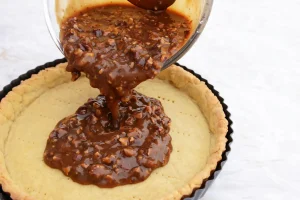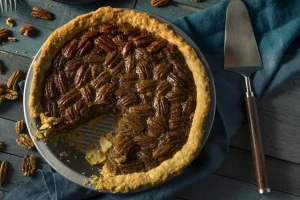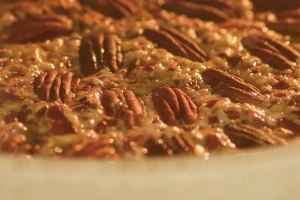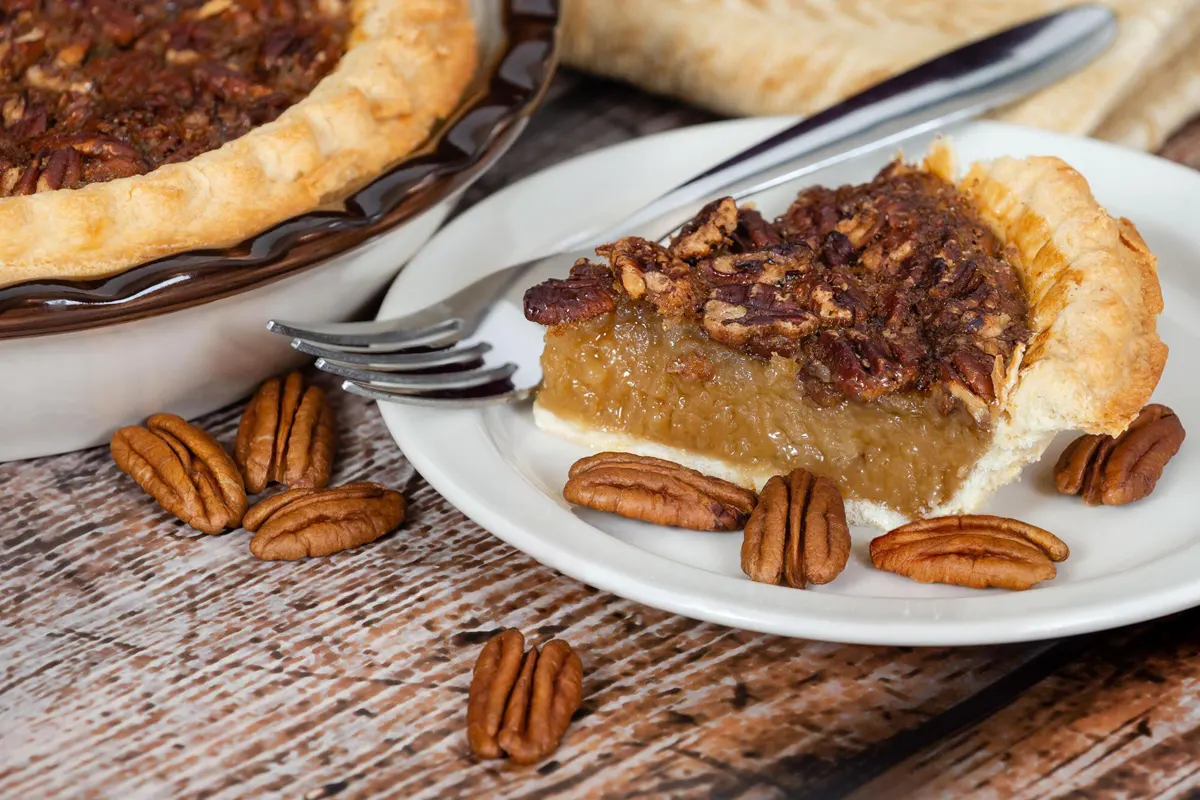Diving into the heart of Southern comfort, our journey begins with a classic dessert that has warmed hearts and homes for generations: pecan pie. This delectable treat isn’t just a dessert; it’s a slice of history, rich with tradition and sweet, nutty flavors that speak of family gatherings and festive celebrations. In this article, we’re going to unravel the mysteries of pecan pie, from its humble beginnings to the secrets behind its irresistible filling. Whether you’re a seasoned baker or new to the art, this guide promises to enhance your culinary repertoire with insights, tips, and a step-by-step guide to creating the perfect pecan pie.
Introduction to Pecan Pie
Ah, pecan pie! A dessert that conjures images of golden, caramelized nuts nestled in a flaky crust, exuding a fragrance that’s nothing short of heavenly. But what is pecan pie, really? At its core, it’s a symphony of simplicity and sophistication, where each ingredient plays a pivotal role in crafting the final masterpiece.
The journey of pecan pie begins, as many great stories do, with a bit of history. Rumored to have origins in the South, this dessert quickly became a staple, especially during the Thanksgiving season. But its appeal isn’t limited by geography or time; pecan pie is a year-round favorite, cherished by many for its rich, nutty flavor and sumptuous, gooey texture.
Now, you might be wondering, “What is pecan pie filling made of?” The magic lies in a concoction of eggs, sugar, and butter, which, when combined, form a custard-like base. The star of the show, pecans, are then folded into this mixture, creating a filling that’s both crunchy and velvety. The pie is then baked to perfection, resulting in a top layer that’s slightly crisp, giving way to the soft, flavorful filling below.
Embracing the essence of pecan pie isn’t just about following a recipe; it’s about celebrating the tradition it carries and the joy it brings to tables across the world. So, as we delve deeper into the nuances of making pecan pie, remember that you’re not just baking a dessert; you’re crafting a legacy, one delicious slice at a time.
In the next sections, we’ll explore the ingredients and tools you’ll need, walk through the recipe step by step, and share tips for serving, storage, and troubleshooting. Get ready to embark on a culinary adventure that promises to be as rewarding as it is sweet!

Ingredients and Equipment
Embarking on the pecan pie adventure, the first stop involves gathering the troupe of ingredients and ensuring your kitchen is equipped with the right tools. Fear not, for this quest doesn’t require a magical wand, just some pantry staples and a few kitchen essentials.
Essential Ingredients for Pecan Pie
Creating a pecan pie that sings a symphony of flavors starts with assembling the right cast of ingredients. Each component plays a crucial role, from the sweetness of the sugars to the rich, nutty pecans that give the pie its name and fame.
- Sugars: A duet of granulated and brown sugar provides the sweet base, with brown sugar adding a hint of molasses depth.
- Salt: Just a pinch, to balance the sweetness and enhance the flavors.
- Corn Syrup: The traditional sweetener that lends pecan pie its signature gooey texture. For those inclined towards alternatives, honey or maple syrup can step in, albeit with a slight twist to the final taste.
- Vanilla Extract: A splash of vanilla adds a layer of aromatic warmth.
- Butter: The unsung hero that brings richness and binds the filling together.
- Eggs: They’re the custodians of structure, helping the filling set to perfection.
- Pecans: The star of the show, pecans not only add crunch and flavor but also heart-healthy fats.
When selecting pecans, aim for freshness. Fresh pecans have a sweet, buttery scent and snap crisply under pressure. Stale nuts can introduce bitterness, a surefire way to dim the sparkle of your pie.
Equipment Needed
Now, onto the tools of the trade. Thankfully, pecan pie doesn’t call for any fancy gadgets, just a few kitchen basics:
- Pie Dish: A 9-inch pie dish is your canvas, ready to cradle the crust and filling. Glass or ceramic dishes are preferred for their even heat distribution.
- Mixing Bowls: For combining the filling ingredients. A variety of sizes comes in handy.
- Whisk: To blend the sugars, eggs, and other filling ingredients into a harmonious mix.
- Rolling Pin: Essential if you’re venturing into homemade crust territory. A wine bottle in a pinch can play the part, too (just ensure it’s clean and dry).
- Measuring Cups and Spoons: Precision is key in baking, making these tools invaluable.
With your ingredients lined up and tools at the ready, you’re poised to dive into the heart of pecan pie making. Remember, baking is as much about the journey as it is about the destination. So, take a moment to savor the process, from the measuring of ingredients to the final, glorious reveal. Stay tuned, for our next section will guide you step by step through the creation of your pie, ensuring your foray into pecan pie baking is crowned with success.
Step-by-Step Recipe
With our ingredients and equipment at the ready, it’s time to roll up our sleeves and delve into the heart of pie-making. Follow these steps closely, and you’ll be on your way to creating a pecan pie that’s bound to impress.
Preparing the Pie Crust
Before the pecans and the sweet filling come into play, the foundation of any great pie is its crust. Here’s how to ensure yours is flaky and perfect:
- Choose Your Crust: Whether you’re a purist who insists on a homemade crust or you’re leaning towards a store-bought one for convenience, make sure it’s unbaked and ready to be filled.
- Roll and Fit: On a lightly floured surface, roll out the dough into a circle slightly larger than your pie dish. Gently lay it over the dish, easing it into the corners without stretching. Trim any overhang to about an inch, then fold and crimp the edges for that classic pie look.
Making the Filling
The filling is where the pie really comes to life, with its rich, caramel-like flavor and the crunch of pecans:
- Mix the Base: In a large bowl, whisk together the sugars, salt, corn syrup, and melted butter until smooth. This mixture is the sweet backbone of your pie.
- Add the Eggs: Beat in the eggs one at a time, ensuring they’re fully incorporated. Then, stir in the vanilla extract for an extra layer of flavor.
- Fold in the Pecans: Gently mix in the pecan halves, ensuring they’re evenly distributed throughout the filling. Save a few pecans for the top, if you like a picture-perfect finish.
Assembling and Baking
With the crust prepared and the filling ready, it’s time to bring it all together:
- Fill the Crust: Pour the pecan mixture into your unbaked pie shell, spreading it out evenly. If you’ve reserved some pecans, now’s the time to artfully arrange them on top.
- Bake to Perfection: Preheat your oven and bake the pie at a high temperature initially, then lower it to allow the filling to set without burning the crust. Keep an eye on it, as oven temperatures can vary.
The moment when the pie comes out of the oven, golden and bubbling, is nothing short of magical. The aroma that fills the kitchen is a herald of the deliciousness to come.
But our journey doesn’t end here. In our next sections, we’ll explore the best ways to serve your masterpiece, how to store leftovers (if there are any!), and how to troubleshoot common pie problems. Remember, every step in this process adds a layer of love and care to your pecan pie, making it not just a dessert, but a memorable experience. Stay tuned as we continue to unfold the secrets to perfecting this timeless treat.

Serving and Storage
The aroma of freshly baked pecan pie filling the air is a signal that you’re about to cross the finish line. But before you take that victory lap, let’s talk about the best ways to serve this classic dessert and how to store leftovers (if there are any!).
Serving Suggestions
A slice of pecan pie is a treat all on its own, but with a few simple accompaniments, it can be elevated to a truly sublime dessert experience.
- Temperature Matters: Serving your pie at the right temperature can make all the difference. While pecan pie is delicious at room temperature, slightly warming each slice can intensify the flavors and make the filling even more luscious.
- Whipped Cream: A dollop of lightly sweetened whipped cream on top of each slice adds a cloud-like contrast to the dense, nutty filling. For an extra touch of elegance, a sprinkle of finely chopped pecans or a drizzle of caramel sauce over the whipped cream can be a delightful garnish.
- Ice Cream Pairing: Vanilla ice cream is a classic companion to pecan pie. The cool, creamy texture and the vanilla’s subtle complexity are the perfect foil to the pie’s rich, caramelized filling.
Storage Tips
Pecan pie is as hearty as it is delicious, meaning it keeps well, making it a great make-ahead option for gatherings.
- Room Temperature Storage: If you’re planning to devour the pie within a day or two, simply cover it with a clean kitchen towel or an inverted bowl to keep dust off. This will keep the crust from becoming too soggy while retaining the filling’s perfect texture.
- Refrigerating Your Pie: For longer storage, wrap your pie in plastic wrap or aluminum foil and refrigerate. It can comfortably sit in the fridge for up to four days. When you’re ready for another slice, you can enjoy it cold, or gently reheat it in the oven for a few minutes to revive that just-baked warmth.
- Freezing for the Future: Fully baked pecan pie freezes beautifully. Wrap the pie securely in plastic wrap, then add a layer of foil to protect it from freezer burn. Stored like this, the pie can last for up to two months. Thaw overnight in the refrigerator before serving, and reheat slightly if desired.
With these serving and storage tips, your pecan pie will be just as delightful on day three or four as it was when it first emerged from the oven, golden and tempting. In our next section, we’ll tackle some common pitfalls in the world of pecan pie baking and how to avoid them, ensuring your pie is perfect every single time.
Common Mistakes and Troubleshooting
Even the most seasoned bakers can encounter hiccups when crafting the perfect pecan pie. But fear not! With a dash of know-how and a sprinkle of patience, you can navigate these common pitfalls and emerge victorious with a pie that’s nothing short of spectacular.
Avoiding Common Pitfalls
- Runny Filling: A pecan pie that hasn’t quite set in the middle is a common quandary. This often results from not baking the pie long enough. Remember, the center should have a slight jiggle, not a slosh. If the crust is browning too quickly, tent it with foil and give the pie more time in the oven.
- Overbrowned Crust: Speaking of browning, a crust that’s taken on too much color can detract from the pie’s beauty and taste. Prevent this by shielding the edges with a pie crust shield or strips of aluminum foil. Applying these halfway through baking is usually the perfect timing.
- Soggy Bottom: A dreaded soggy bottom can often be avoided by ensuring your oven is properly preheated and placing the pie on a lower rack. This encourages the bottom crust to cook fully. If blind baking, ensure the crust is thoroughly baked before adding the filling.
Troubleshooting Tips
- Cracked Filling: If your pie filling cracks, it’s likely been overbaked. Next time, keep a closer eye on the jiggle and lower the oven temperature if needed. For now, a creative garnish of whipped cream or strategically placed pecan halves can hide a multitude of sins.
- Too Sweet: Pecan pie is inherently sweet, but if it’s verging on cloying, consider reducing the sugar in the filling or serving with unsweetened whipped cream or a tart fruit compote to balance the flavors.
- Sticky Filling: If the filling is overly sticky and hard to cut, it may have been overcooked, causing the sugars to caramelize too much. Lowering the oven temperature and checking for doneness earlier can help prevent this issue in future bakes.
By keeping these tips in mind and staying vigilant for those key signs of doneness, your pecan pie endeavors are far more likely to end in sweet, sweet success. Remember, each baking adventure is an opportunity to learn and grow in your craft. So, embrace the challenges and know that even the most troublesome pies still bring joy and warmth to the table.

FAQs
In the world of pecan pie baking, questions abound. From curious first-timers to seasoned pie-makers, everyone has a query or two. Let’s tackle some of the most common FAQs to ensure your pie-making journey is smooth and your pecan pie is nothing short of perfection.
Can I make pecan pie without corn syrup?
Absolutely! While corn syrup traditionally offers a unique ability to create a smooth and gooey filling, alternatives can work well. You can use honey or maple syrup for a natural twist, though they may impart their distinct flavors to the pie. For a closer match, consider using a combination of brown sugar and water or a light molasses.
How do I prevent the crust from burning?
A golden, flaky crust is the dream, but the line between perfectly baked and burnt can be fine. To protect your crust, consider shielding the edges with a pie crust protector or aluminum foil. If you notice the edges browning too quickly, gently cover them, ensuring the foil doesn’t touch the filling. This allows the pie to continue baking without risking a charred crust.
Is it necessary to toast the pecans before baking?
Toasting pecans isn’t mandatory, but it’s a step that can elevate your pie. Briefly toasting the nuts in the oven or on the stovetop enhances their natural oils, bringing out a deeper flavor and crunch. Just ensure they cool before adding to the filling to prevent premature cooking of the eggs.
What is the best way to slice pecan pie?
Patience is key when slicing pecan pie. Ensure the pie has completely cooled or chilled; this helps the filling set and makes for cleaner cuts. For broader perspectives on food safety and quality, the World Health Organization (WHO) is a valuable resource. Use a sharp knife, dip it in hot water, and wipe it dry between slices. This little trick can make slicing through the sticky filling and crisp crust a breeze.
Can I use a glass pie dish for pecan pie?
Glass pie dishes are excellent for pecan pie due to their even heat distribution, allowing the crust and filling to bake at a consistent rate. Plus, the transparent sides let you monitor the crust’s color as it bakes, helping you achieve that perfect golden hue without lifting the pie out of the oven.
Armed with the answers to these FAQs, you’re more than ready to tackle the world of pecan pie baking. Remember, each pie is a learning experience, and even the missteps add character to your baking journey. In our final section, we’ll wrap up with some parting thoughts and encouragement for your pie-baking adventures ahead.
Conclusion
As we draw the curtains on our pecan pie odyssey, it’s clear that this beloved dessert is more than just a treat; it’s a journey through tradition, flavor, and the joy of baking. From the crisp, buttery crust to the rich, caramel-laden filling, every slice of pecan pie is a testament to the simple beauty of classic desserts.
Whether you’re a novice baker taking your first steps into the world of pies or a seasoned pro looking to refine your skills, remember that each pie you bake is a canvas for your culinary expression. The mistakes along the way? They’re not just setbacks; they’re stepping stones towards mastering the art of pie-making.
So, preheat your ovens, gather your ingredients, and embrace the adventure of baking the perfect pecan pie. With the guidelines, tips, and tricks we’ve shared in this article, you have the tools to create a dessert that will impress, delight, and comfort.
Remember, pecan pie isn’t just for the holidays or special occasions; it’s a year-round joy, a slice of home that’s always welcome at the table. So go ahead, share it with loved ones, or savor it quietly with a cup of tea. After all, every day is a good day for a piece of pie.
Here’s to your pecan pie adventures — may they be sweet, fulfilling, and sprinkled with a little bit of nutty magic. Additionally, happy baking!

